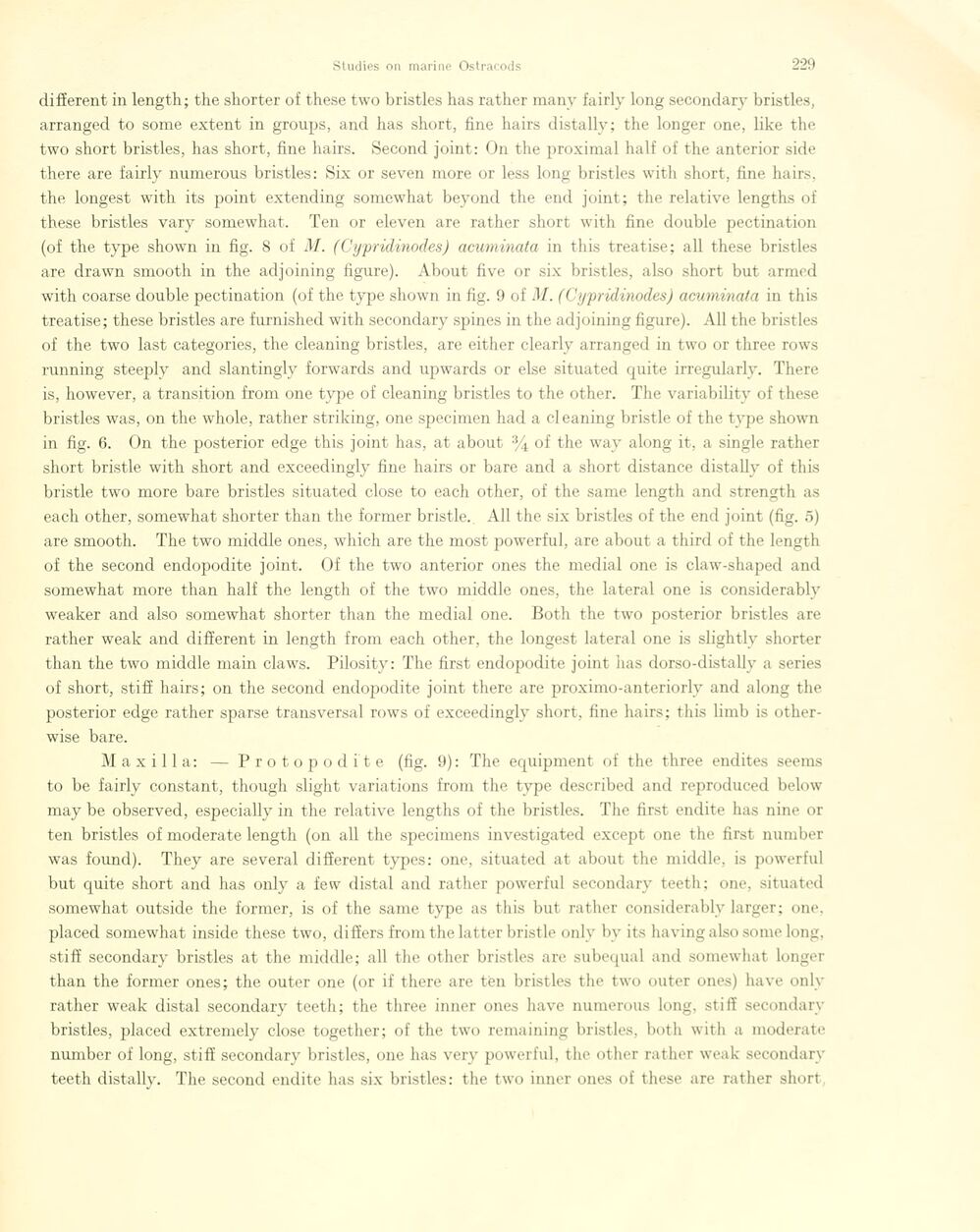
Full resolution (JPEG) - On this page / på denna sida - Sidor ...

<< prev. page << föreg. sida << >> nästa sida >> next page >>
Below is the raw OCR text
from the above scanned image.
Do you see an error? Proofread the page now!
Här nedan syns maskintolkade texten från faksimilbilden ovan.
Ser du något fel? Korrekturläs sidan nu!
This page has never been proofread. / Denna sida har aldrig korrekturlästs.
different in length; the shorter of these two bristles has rather manv fairly long secondary bristles,
arranged to some extent in groups, and has short, fine hairs distally; the longer one, like the
two short bristles, has short, fine hairs. Second joint: On the proximal half of the anterior side
there are fairly numerous bristles: Six or seven more or less long bristles with short, fine hairs,
the longest with its point extending somewhat beyond the end joint; the relative lengths of
these bristles vary somewhat. Ten or eleven are rather short with fine double pectination
(of the type shown in fig. 8 of M. (GypriAinod.es) acuminata in this treatise; ail these bristles
are drawn smooth in the adjoining figure). About five or six bristles, also short but armed
with coarse double pectination (of the type shown in fig. 9 of M. (Cypridinodes) acuminata in this
treatise; these bristles are furnished with secondary spines in the adjoining figure). All the bristles
of the two last categories, the cleaning bristles, are either clearly arranged in two or three rows
running steeply and slantingly forwards and upwards or else situated quite irregularly. There
is, however, a transition from one type of cleaning bristles to the other. The variability of these
bristles was, on the whole, rather striking, one specimen had a cleaning bristle of the type shown
in fig. 6. On the posterior edge this joint has, at about % of the way along it, a single rather
short bristle with short and exceedingly fine hairs or bare and a short distance distally of this
bristle two more bare bristles situated close to each other, of the same length and strength as
each other, somewhat shorter than the former bristle. Ail the six bristles of the end joint (fig. 5)
are smooth. The two middle ones, which are the most powerful, are about a third of the length
of the second endopodite joint. Of the two anterior ones the medial one is claw-shaped and
somewhat more than half the length of the two middle ones, the lateral one is considerably
weaker and also somewhat shorter than the medial one. Both the two posterior bristles are
rather weak and different in length from each other, the longest lateral one is slightlv shorter
than the two middle main claws. Pilosity: The first endopodite joint lias dorso-distally a series
of short, stiff hairs; on the second endopodite joint there are proximo-anteriorly and along the
posterior edge rather sparse transversal rows of exceedingly short, fine hairs; this limb is
other-wise bare.
Maxilla: — Protopodite (fig. 9): The equipment of the three endites seems
to be fairly constant, though slight variations from the type described and reproduced below
may be observed, especially in the relative lengths of the bristles. The first endite lias nine or
ten bristles of moderate length (on all the specimens investigated except one the first number
was found). They are several different types: one, situated at about the middle, is powerful
but quite short and has only a few distal and rather powerful secondary teetli; one, situated
somewhat outside the former, is of the same type as this but rather considerably larger; one.
placed somewhat inside these two, differs from the latter bristle only by its having also some long,
stiff secondary bristles at the middle; all the other bristles are subequal and somewhat longer
than the former ones; the outer one (or if there are ten bristles the two outer ones) have only
rather weak distal secondary teeth; the three inner ones have numerous long, stiff secondary
bristles, placed extremely close together; of the two remaining bristles, both with a moderate
number of long, stiff secondary bristles, one has very powerful, the other rather weak secondary
teeth distally. The second endite has six bristles: the two inner ones of these are rather short
<< prev. page << föreg. sida << >> nästa sida >> next page >>